Best-laid plans: How Texans crafted plays for their season's biggest game

A version of this story appears in the Jan. 4, 2016, issue of Sports Illustrated. Subscribe to the magazine here.
With 6:52 remaining in the second quarter in Houston on Sunday, the Texans start their huddle at the Jacksonville 33-yard line, facing third-and-one. They hold a 10–3 lead with an AFC South title and the third playoff berth in the franchise’s 14 years on the line. If they’re stopped, the 50-yard field goal attempt would be at the edge of kicker Nick Novak’s range. To the 71,054 fans at NRG Stadium, it’s clear that this will be one of those plays that decide their team’s season.
Offensive coordinator George Godsey, bald head peeking over his trusty call sheet, sends out his heavy personnel: two backs (one fullback), two tight ends (including reserve lineman Kendall Lamm) and receiver DeAndre Hopkins split left. The Jaguars counter with their base package, loading nine defenders in the tackle box. Only free safety Sergio Brown and cornerback Davon House, matched up wide against Hopkins, are outside spitting distance of quarterback Brian Hoyer.
10 storylines for NFL playoffs: Victory droughts, lack of newcomers, more
When an NFL offense flounders, coordinators like Godsey bear the glare of the public spotlight. But if you go behind the scenes, it’s immediately apparent that a game plan is a collective effort. Last week the Texans gave Sports Illustrated rare and exclusive access to the hours of discussion, research, film study and creative energy that shaped their offensive strategy for one of the biggest games in team history. From Godsey and coach Bill O'Brien to their assistants and the players, everyone had substantial input into the overall scheme as well as the individual play calls.
“I really don’t think you go into a game thinking, “Man, this game plan sucks,’ because it is a collaboration,” Hoyer said five days before he would make his first start since Dec. 13, when he suffered his second concussion in less than a month. “We’re talking about it all week. You’re just hoping you get the plays at the right time against the right defense.’
As he approaches the line, Hoyer is confident that all that scheming has paid off. He eagerly demands the snap with 13 seconds left on the play clock, because this is exactly the defensive look that Godsey hoped would be there when he made his call.
Omaha ... set go!
*****
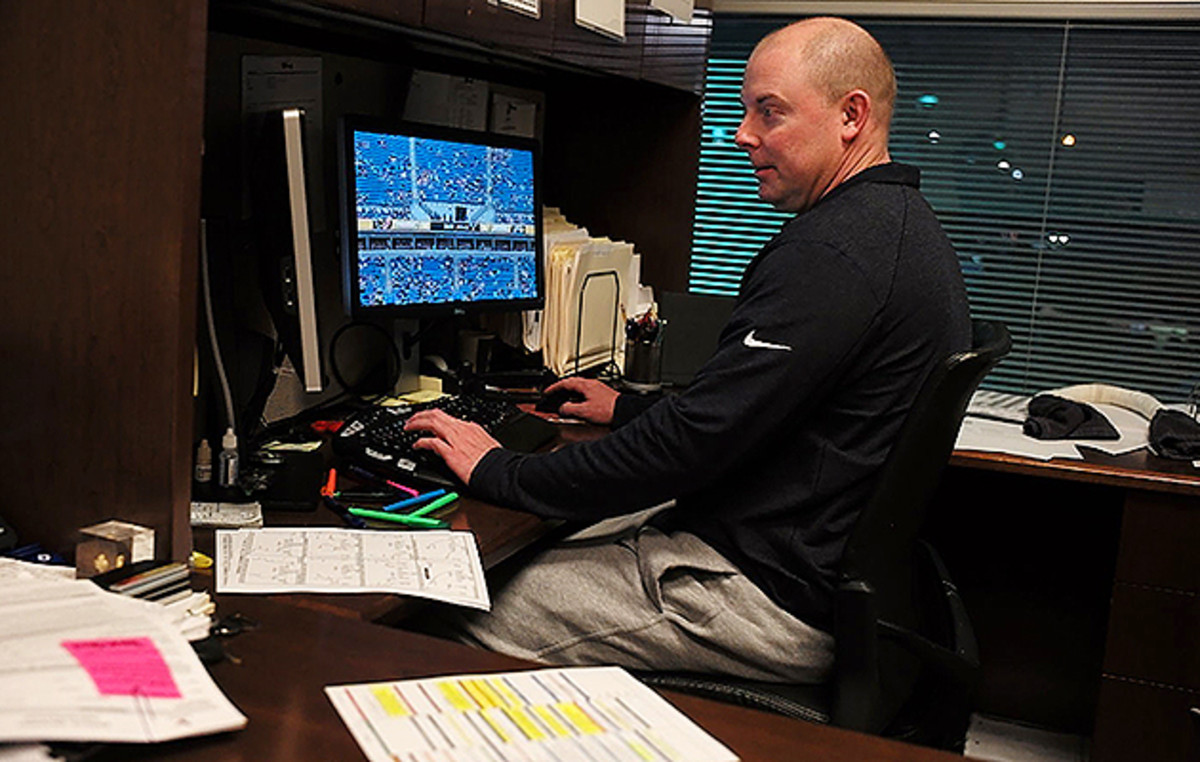
It’s 1 p.m. on Monday, Dec. 28, and the Texans have put the previous day's 34–6 victory over the Titans to bed and turned their attention to the Jaguars. While the players are off until Wednesday, the coaches have been at the office since a little after 4 a.m.
Two members of the staff got the biggest jumps in preparation. Director of football research Jim Bernhardt (O’Brien’s defensive coordinator when he played at Brown and longtime consigliore) works a week ahead and had a scouting report on the Jaguars prepared for O’Brien before the game against the Titans. Tight ends coach John Perry goes from the plane to the film to look for tendencies of both the Texans and the Jaguars. What Perry unearths on both teams will have a significant impact in gameplanning as the week goes on.
Colts show prudence letting Pagano, Grigson work through issues
Following the blueprint in New England—where O'Brien and Godsey worked under Bill Belichick—Houston has developed what's called a “game-plan offense,” meaning that it varies based on the strengths and weaknesses of the opponent. Godsey sits before two computer monitors; film runs on one, and a blank play-call sheet appears on the other. The sheet is formatted with different categories: drive starters, play action, boot sprints, quick dropbacks, empty formation, second-and-short, two minute etc. All week long Godsey will fill in the sheet by pulling a play call from old sheets (there are at least a dozen pages of calls grayed out on Excel files in the background), getting input from his fellow coaches or creating new plays (with bits of other familiar concepts) by drawing alignments and routes on a coaching pad that already has offensive linemen on it.
“The key is to make all these concepts, whether they are run or pass, look similar to other plays,” says Godsey, a 37-year-old former Georgia Tech quarterback who's wearing a baseball cap, T-shirt and sweatpants. “If you can do that, then you have something, because in theory, the defense shouldn't know what to expect.”
While looking at these plays, Godsey’s phone dings with a text message. It’s from quarterback Brian Hoyer, who is in Pittsburgh getting his final clearance from his concussion. It’s important to keep in mind that there are a ton of text messages sent during the gameplan process, from coach to coach, and coach to player. If only Vince Lombardi and Bart Starr had that technology…
“Hey, paratrooper this week?” Hoyer texted in reference to a curl concept against zone defenses (actual terms and play names have been changed).
“Ok,” Godsey replied, along with a picture of what he had in his call sheet at that point. “Which three do you like out of these empty plays?”
“Everything except coffee draw,” Hoyer responded.
“If we go to Motown (personnel grouping with two tight ends), lets do these two plays,” texted Godsey.
“Yup, both are good,” Hoyer responded.
“Zero lean over zag, quick 62 F bam bow scissors?” Godsey asked.
Another text had to do with the paratrooper play and if the Texans wanted to have an alert (alternate play depending on coverage; half the plays have an alert, which is basically having two plays at the line of scrimmage) if it’s man coverage. More than a few emojis are used, complete with Hoyer throwing out the cash sign to Godsey, an acknowledgment that Hoyer wants their cash pass concept included. Ah, gameplanning in the 21st century.
For the Texans, every game plan starts with Hopkins, the talented third-year Pro Bowl receiver who has already posted the fourth-most receptions (104) and receiving yards (1,432) in a single season.
Godsey spends nearly three hours looking for ways to spring Hopkins from the close coverage from Jaguars cornerback Davon House. The Texans have noticed that House is extremely grabby when playing press man coverage against Hopkins, and Godsey thinks he’s hit on something based on the boot actions the Falcons used on their opening possession in their 23-17 victory over the Jaguars on Dec. 20 the other offensive assistants are tackling their portions of the gameplan.
Receivers coach Stan Hixon and offensive assistant Pat O'Hara come up with red-zone plays. Running backs coach Charles London is in charge of identifying Jacksonville's blitz tendencies and plotting the two-minute drill. Tight ends coach John Perry handles certain game situations—third downs, four minutes (that is, running out the clock) and being pinned deep.
Offensive-line coach Mike Devlin handles the running game and draws up the protections on chosen pass plays. Tim Kelly, the offensive quality-control coach, speeds the process by breaking down film in advance, which includes labeling Jacksonville's plays in Texans-speak for each assistant (the same grunt job O’Brien and Godsey held in their infancy in New England).
They will all come up with calls they think will work, along with clips of the Jaguars' various defensive schemes in different situations. Each coach adds comments into the team's XOS Digital film system to alert others to plays that Houston should run or avoid, then discusses them directly with Godsey. Over the course of the week, he and Devlin will go to the offensive coaches' meeting room and present each package in the game plan to O’Brien for his approval.
Against the Jaguars, the Texans want to utilize a play-action pass out of the formations that use a halfback and fullback. Perry’s scout has revealed that the Texans have 11 runs and zero passes with two backs in the backfield the past two games. The Jaguars likely know this as well, so Godsey will try to find a way to “surprise” Jacksonville with a play-action pass out of that set. The tendency comes up as well for London as he scouts blitzes, but also keeps an eye out for what he needs to teach his room.
“Atlanta may have had the same kind of tendency,” says London, as he watches the Falcons run a boot pass with two backs. “We’ll definitely look at that. This week, when we put our fullback in, let’s do play-action, let’s run a boot, let’s try, early on the game, to break that tendency of what we’ve been doing … to give them a new wrinkle to look at.”
Off the Grid: Two views of Concussion, a Q&A with Leigh Steinberg and more
There are a few things about the 5–10 Jaguars that worry the 8–7 Texans. O’Brien, who will later tell the team adamantly that Jacksonville will come to play, goes from office to office telling anyone who will listen that the Jacksonville enters the game third in the league in rushing defense with 3.6 yards per carry. It’s no surprise when Godsey flips on the film and you see country-strong nose tackle Roy Miller penetrate opposing offensive lines, linebacker Telvin Smith (whom would later be ruled out with a shoulder injury) outrun would-be blockers to make plays from sideline to sideline and strong safety Jonathan Cyprien blow up plays in the box. All three are a concern to the point that Houston’s scout team members will be wearing their numbers. The Texans have to block those players or the plan could go up in smoke.
“He concerns me more than anybody,” O’Brien says of the speedy Smith. “He can fly.” Miller will be double teamed or run away from on every play.
Late on Monday afternoon, O’Brien heads from his office on the second floor of the facility to his game-day office next to the locker room. His normal office can be a high-traffic area, so the other office is a bit of a refuge, featuring an old brown couch where he can sleep if needed.
The most important reason for that office to be near the locker room is to be accessible to the players, who will often stop by and chat. But the players are off this day so O’Brien grinds through four or five games of Jaguars film, watching all three phases. O’Brien delegates much of the game-planning process to his staff, which is the way Belichick does it in New England.
“I let them coach,” O’Brien says. “Bill let us coach. On Tuesdays you’d have to go in there and present the gameplan to him, but other than that, he let us go. I just try to give them guidance on how I want the team to look like. They have to be able to go and be creative and come up with good ideas.”
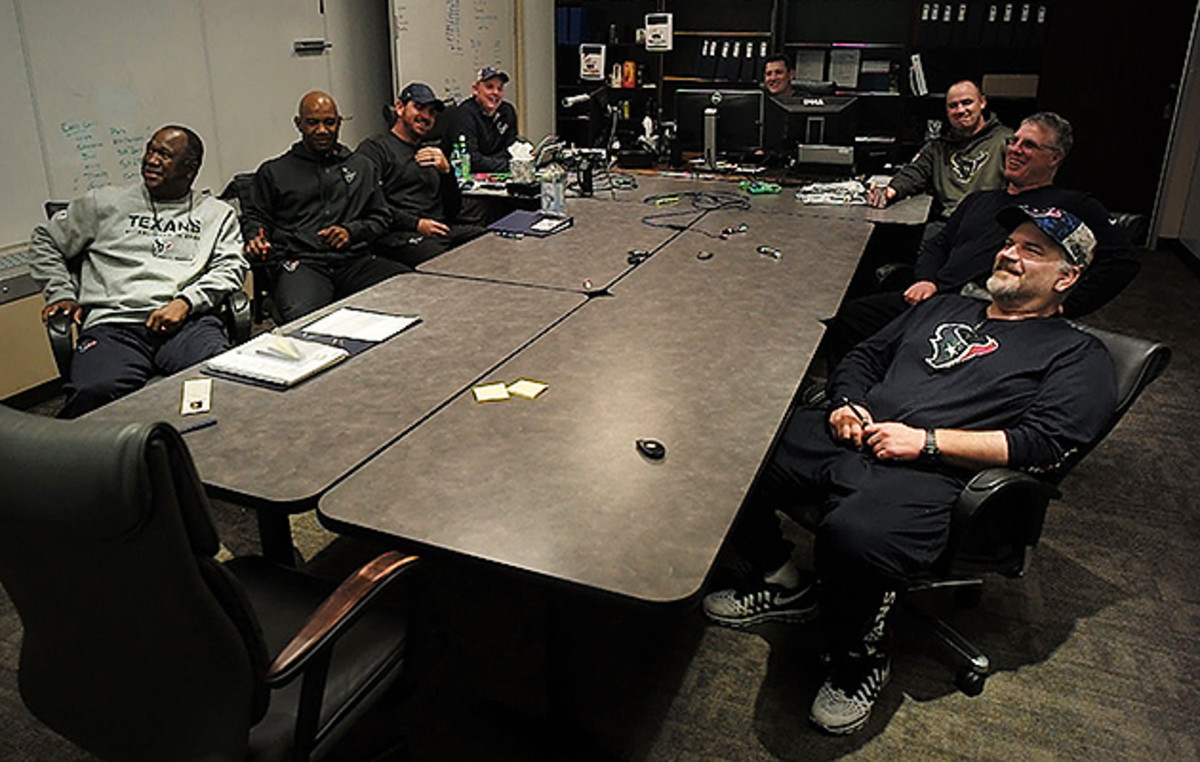
At 9 a.m. Tuesday, O’Brien convenes his first staff meeting of the week; he review notes from the Titans’ game, presents what he learned from his review of Jaguars’ tape and provides updates on the team’s (and their opponent’s) injury situation.
Then, O’Brien, Godsey and Devlin head to the offensive meeting room to discuss the early stages of the game plan and scrutinize the Jaguars’ previous game film.
In their previous three meetings against Gus Bradley’s unit, Houston has successfully run right at them with power plays, averaging 129 yards per game. Dressed-up versions of those concepts—different personnel and alignment—are installed in the game plan featuring Alfred Blue, the team’s 6'2'', 223-pound power back. But the Texans are also going to try to get the edges in the run game after watching the Falcons and Saints exploit the Jaguars there.
“What do you think about tossing it, George?” O’Brien asks during a 90-minute, state-of-the-gameplan Tuesday night meeting with Godsey and Devlin to go over first and second downs and the running game. (They’ll have similar meetings the next two nights to cover third downs and the red zone, with the passing game mixed in.)
“Well, there’s two ways to look at it,” Godsey says while scarfing down a snack. “One, they’re faster than us but, two, there’s some angles we’ve got. I feel like we have angles to run that toss, it’s just a matter of making sure we don’t overrun them.”
Cleveland should be optimistic after Browns' innovative DePodesta hire
O’Brien throws up some clips he saved from New England’s recent loss to the Jets, highlighting how the Patriots are using running back Brandon Bolden to bring a speed element to their pass and run game.
“Can anybody do that for us? Hunt?” O’Brien asks about the undrafted free agent speed back Akeem Hunt, who was a college free agent and spent time with the Giants and Ravens.
“We've got something with that,” Godsey says, then goes through his list of possibilities, including a belly toss play that calls for a fake to the fullback, then a backside toss to the halfback—usually Blue.
“I love the play,” O’Brien says. “What do you think about tossing that to Akeem? They’ve got speed. Maybe we have a little bit of speed with the toss. I love the play, I just know [the Jaguars] are going to be fast in pursuit,” O’Brien says. “But we do have angles, so maybe Akeem …”
“...can outrun it?” Godsey finishes the sentence. “Yeah, maybe it should really be his play.”
Godsey also mentions running boot out of two-back personnel to break their own tendency, and his plans to get the ball to Hopkins.
“Love it,” O’Brien says.
The Texans also draw up an extensive package that will feature a bunch formation with wide receiver Jaelen Strong and both tight ends, C.J. Fiedorowicz and Ryan Griffin.
“Oh yeah,” O’Brien says, while Godsey is drawing on the white board. “That might be one of your better plays on Sunday. I think that’s a great idea.”
After watching the Bills gash Jacksonville with read option in Week 7, Houston also implements an extensive Wildcat package with quarterback B.J. Daniels, who was claimed from the Seahawks' practice squad on Dec. 21. O'Brien likes the Wildcat (dubbed Devil this week) because it not only forces teams to prepare for a wrinkle but also gives his quarterback a breather.
On Tuesday night, the coaches spend hours putting together plays to be fed into the players’ tablets. Godsey sits with O’Hara, who draws the plays on the computer, tailoring every precise route to the formation. Devlin’s in his office drawing the blocking assignments on a pad, while Kelly tries to keep things organized, meshing it with O’Hara’s work. Each page of plays is circulated among the staff to see if there are any errors or adjustments that need to be made. They won’t leave to after midnight. Despite being exhausted from 20-hour days while the players were off, the coaches will be ready for the heaviest day of the week come morning.
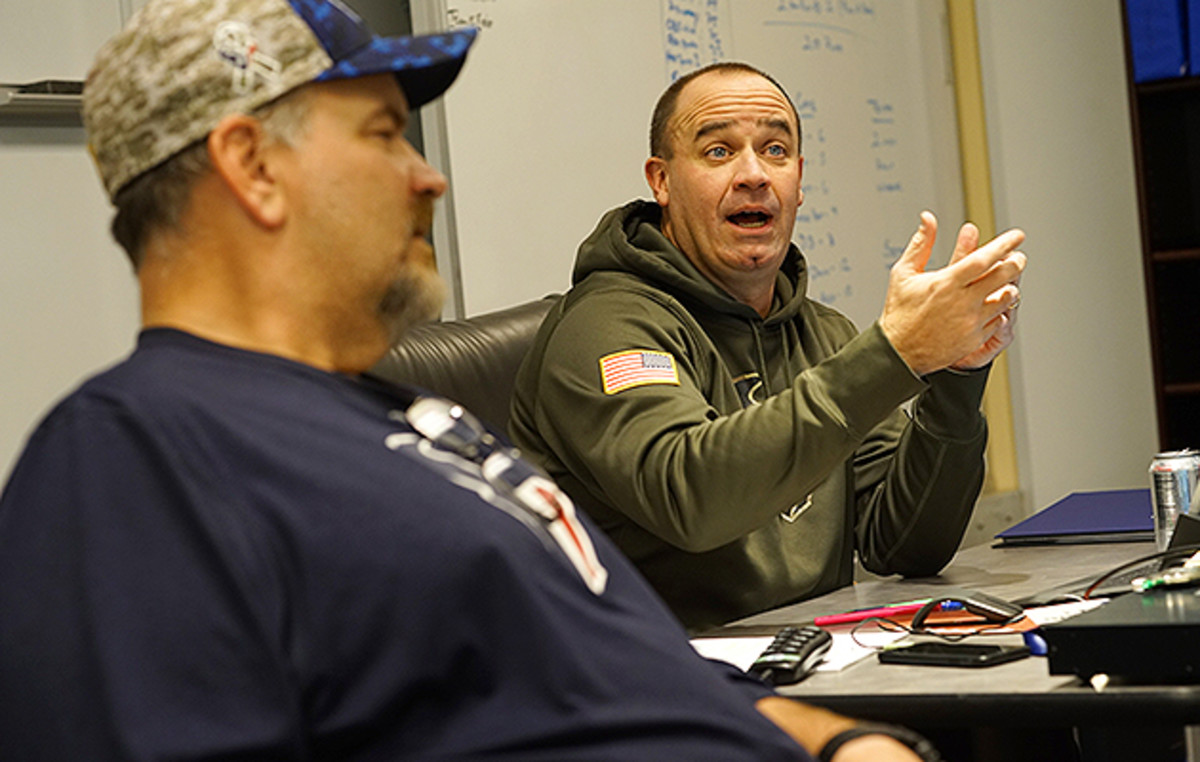
It’s now 7 a.m. on Wednesday, and the auditorium is packed with offensive players. Despite being off since Sunday night and players wearing various stages of t-shirts and sweats, there’s no cordial greeting or chitchat. They may be playing a game for a living, but there is a Fortune 500 seriousness to the matters at hand.
Devlin is at the overhead projector, going through the normal down and distance plays that will be run this week.
“If you go to the picture over here to the left, the weak safety’s down being alert to the flip off of this,” Devlin says. “You’re coming down here and on tape, this guy doesn’t even look. You can get a kill shot on the end; the Z and the F are first defender inside off the ball. Stay on your track. Now, not sure if you guys knew this, but we have a New Year’s baby named George Godsey and all he really wants is, what do you think? Eighty-eight out the gate!”
That’s Texans-speak for big play touchdown. That phrase is uttered several times during the meeting. Yes, the Texans like this plan.
After unit meetings, everyone assembles in the auditorium allowing O’Brien to set the tone for the week.
2016 NFL Mock Draft: With the order (mostly) set, who goes where?
“All you’re going to hear this week from the media is that Indianapolis needs 10 teams to lose. ... Get the hell away from that. Like, I don’t even want to hear that,” O’Brien yells. “Everything we do is about winning. The only thing that we need to focus on is the Jacksonville Jaguars. Each and every guy in this room, coaches, players, trainers, equipment guys, everybody… should be doing their role at the highest level because it’s all about winning the division.
“When we were sitting here at 2–5, one of the first things I said to you was, ‘Hey, look, it’s 2–5, it is what it is, but in the end it’s still about the division.’ The key is to remember that. And don’t worry about all these stupid scenarios. That just fills their time on TV. It’s about winning. It’s about winning!”
The morning’s breakneck pace continues in the quarterback meeting room as Godsey reviews the plays with Hoyer, Brandon Weeden, Daniels and Tom Savage (currently on the injured reserve). Godsey puts the quarterbacks through a relentless pace that doesn’t wait for the timid.
“How are we blocking this?” Godsey asks Hoyer.
“So, they’re going to pull for the Mike [the middle linebacker], right?” Hoyer replies.
“Yeah, so these guys are acing [doubling up] to who?” Godsey fires back.
“To the Will,” Hoyer answers.
“The guard is doing what?” Godsey asks.
“He’s pulling,” Hoyer responds.
“No,” Godsey says sternly. “That’s why I want you to understand it. He’s making a ‘U’ call so he’s blocking the three, the tackle’s pulling…”
“So we’re cutting the end,” Hoyer says.
“Yes, that’s why if you don’t bring him in, the play is screwed because he’s just going to chase it down,” Godsey says.
“Gotcha,” Hoyer says, ending this play before the beat goes on.
After the offense convenes for another meeting, where Godsey goes over the finer points of the gameplan, the team hits the field for a brisk, two-hour practice. There are four team periods where both the offense and defense get to run six plays each against the scout team (which is running Jacksonville’s scheme using drawn up playcards). Hoyer nearly throws an interception using the parachute concept he lobbied for, but otherwise all the plays put into the game plan seem to be working right, especially the Daniels “Devil” package. Sometimes plays need to be thrown out after seeing it on the field, but only small tweaks will be made this week.
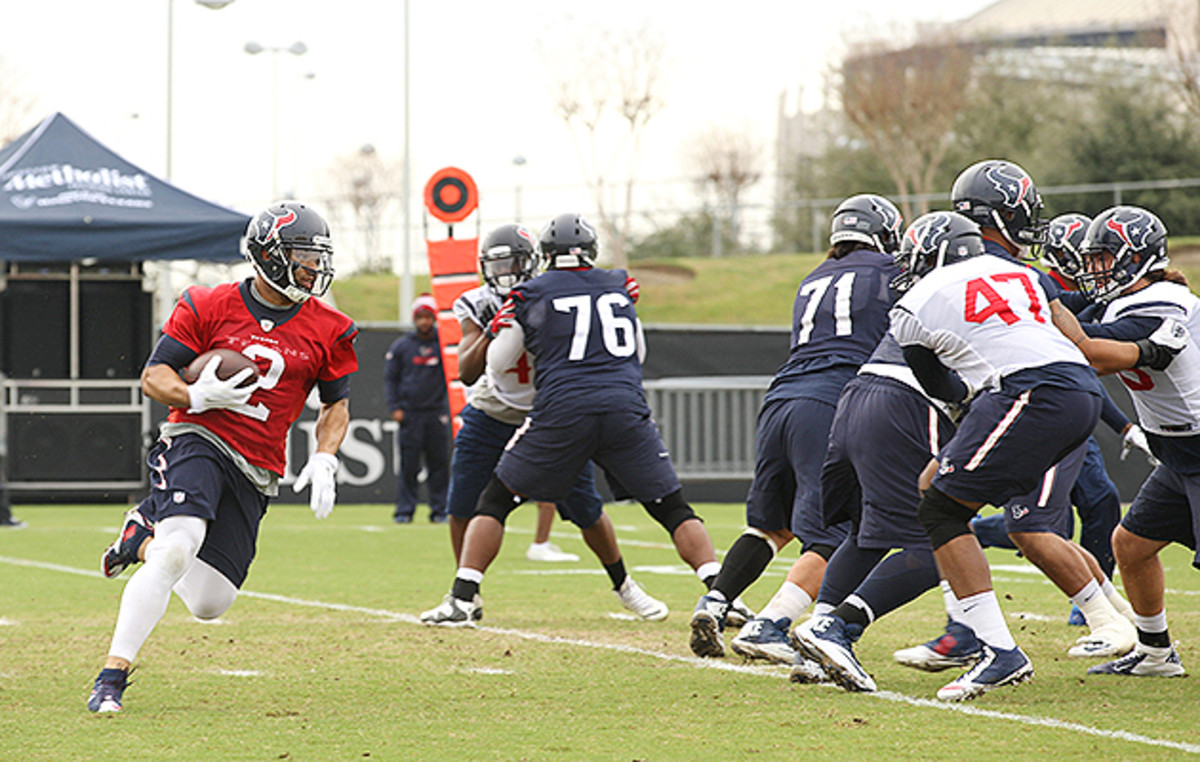
After post-practice unit meetings and then walkthroughs to help visualize the new plays,
O’Brien, Godsey and Devlin head back to the offensive meeting room after post-practice unit meetings and walkthroughs to help visualize new plays. Now, they’ll go over the Jaguars pressure packages, and Perry has discovered some Jacksonville tendencies that even surprise O’Brien.
“John did a good job on this one: on third-and-short yardage, they are 0% blitz on the season,” Godsey announces.
“Zero percent for the season?” O’Brien says incredulously.
“The pressure reduces in long yardage. Anything over 12 yards is 0%. On third-and-medium, it’s 70%,” Godsey says. “And they have changed completely from our first game as far as their philosophy on this down.”
“Wow,” O’Brien says.
The Texans think they’ve found a weakness in the Jaguars’ blitz zone, in which the defenders pass the receivers off instead of matching up. If they run a shallow cross, it could bust big.
“We might have a shot to hit it,” Godsey says. “They do a really nice job with their stunts inside. [Defensive end Chris] Clemons is really good at it.”
“You can tell he’s coming because he’s off the ball,” says Devlin, who has already run his linemen through these troublesome stunts in walkthroughs during the special teams portions of practice.
NFL Playoff Power Rankings: Panthers claim top spot; Broncos, Patriots slide
With a couple of the Jaguars’ more exotic blitzes, O’Brien quizzes both Devlin and Godsey on whether the Texans will pick it up by “popping” the center out to pick up the stray blitzer outside the tackle, or “search” when the center, guard and tackle are eyeing four possible rushers. If they all come, the quarterback is responsible for the extra rusher.
The Jaguars are just about 100% pressure when they go to their dime package and an odd number of lineman. Safety Sergio Brown, a former Patriot, is the extra defensive back.
“He’s always a blitzer and it’s a multiple blitzer,” Godsey says. “It’s either him and the guy from his side, the star. Or it’s basically him and the guy on the opposite side.”
“You’ve got some real tendencies here, huh?” O’Brien says. “To be able to tell the players, that’s good stuff by John.”
The trio ran through a bunch of possible plays to counter the blitz, and then return to the Bills film. When they see the holes Buffalo and offensive coordinator Greg Roman were able to open with read option, a few whistles are heard. What follows is a meandering 40-minute conversation that produces a play from scratch.
Devlin asks about a play the 49ers used to “work” Devlin’s Jets. “What year was this?” Devlin asks. “Can you narrow it down for me and just give me the year? Can we start with that?”
It was a 34–0 Jets loss to the 49ers in which Colin Kaepernick ran five times for 50 yards, including a seven-yard touchdown run. Kaepernick ran behind two tight ends, a fullback and a pulling tackle, but they never made it there.
“Only Godsey would remember this stuff,” O’Brien says.
In the XOS video system Godsey instead calls up the identical play the 49ers ran for 10 yards down to the four-yard line against the Patriots later that season, when Godsey was their tight ends coach.
“Oh, I remember this,” says, who was at Penn State at the time. “This is a great play, George. I know exactly what you’re talking about. That’s so hard on the defense. It’s basically their goal line package. That’s a good play.”
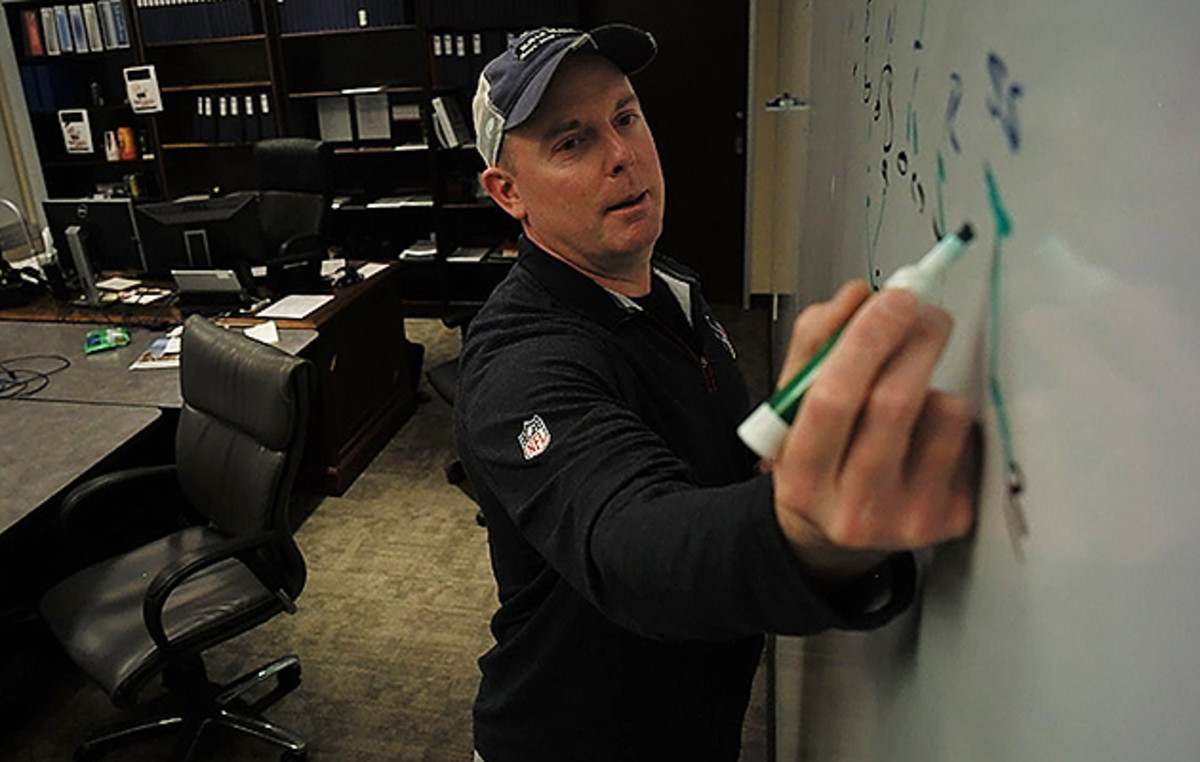
They discuss a similar play the Jets ran with Mike Vick last season, a play the Bills have used and a comparable concept from Houston's own playbook, and then Godsey goes to the whiteboard. Daniels would replace Hoyer; Hunt would be in the offset-I to Daniels's left; two tight ends and receiver Jaelen Strong would be on the same side, in a trips package just off the line. Daniels would fake a handoff around right end to Hunt. While the Jaguars are confused or falling for the fake, the trips would crash down on the end and linebackers, and Daniels would sprint around the left end with a guard pulling in front.
“I don’t really see their ends being conscious of that, do you?” Godsey says, performing the crucial part of game-planing: predicting how the defense will react based on film study.
“You’re going to get some serious crashing,” O’Brien says. “Looks great.”
How the Janet Jackson halftime show aftermath changed the Super Bowl
The entire conversation about this one play takes 39 minutes, but O’Brien says that’s nothing. In 2007, in preparation for the Patriots’ divisional playoff game against the Jaguars, offensive coordinator Josh McDaniels, receivers coach Nick Caserio (now director of player personnel) and O’Brien, then a low-level offensive assistant, spent three hours designing a play. They even moved all the tables and chairs out of their meeting room and brought in a football to work through the timing and ball skills needed to run the play.
The result was a seven-yard touchdown pass from Tom Brady to Wes Welker that broke a 14–14 tie midway through the third quarter. The play involved two fakes: a direct snap to running back Kevin Faulk, and Brady feigning a high snap. Brady actually caught the ball while spinning, put it on his hip, and then connected with Welker in the back of the end zone.
“I was the center, Josh was Brady and Nick was the back and Welker,” O’Brien says. “It took us forever.”
By Sunday the Texans have installed six plays for third-and-short, a situation they've been in 13 times in their three previous meetings with the Jaguars.
“Watch, we won’t get one now,” says Godsey, who added on the eve of the game that if the Texans achieved 4.0 yards per carry against the Jaguars’ stingy run defense it’d be a good indicator of a pending victory.
*****
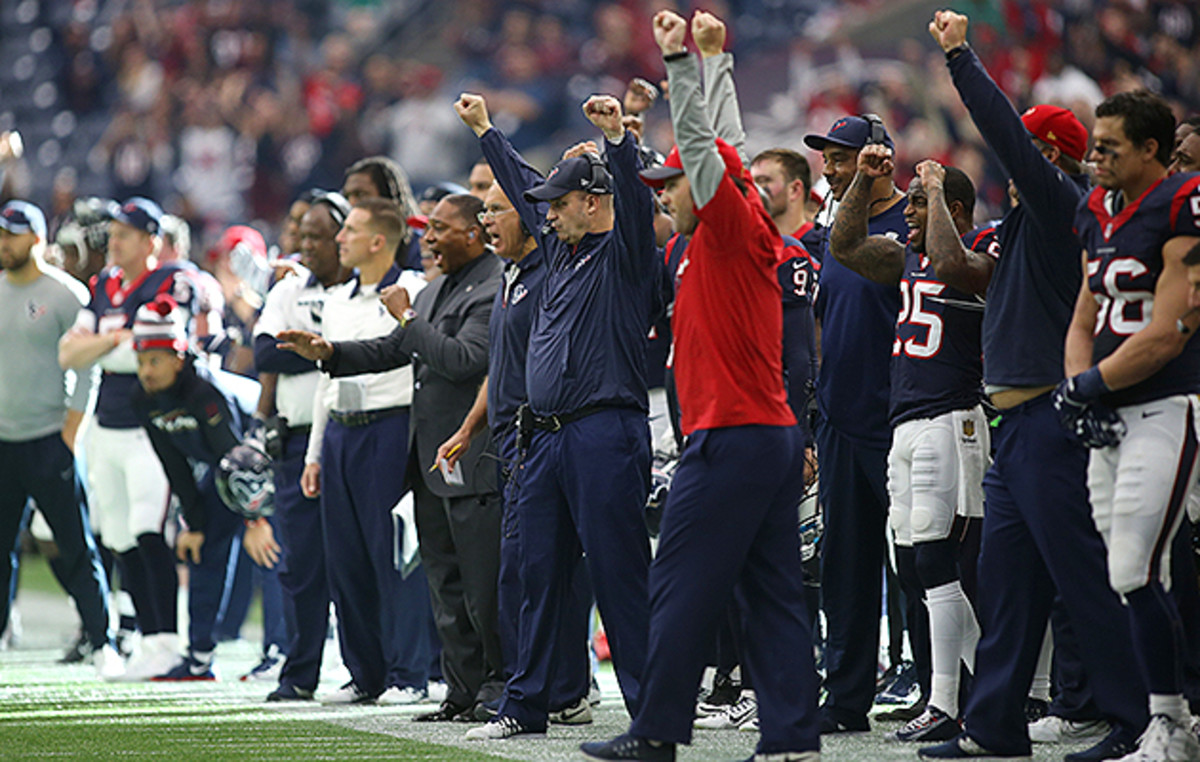
On that third-and-one midway through the second quarter, Godsey chose to test the Jaguars' defense on the edge, using Hunt on the belly toss that O'Brien had endorsed.
Exiting the huddle, Hoyer saw that weakside linebacker Hayes Pullard (Smith's replacement) was inside the tackle box. Had Pullard lined up outside, Hoyer would have alerted—that is, used the tagged alternate play call.
“I snapped the ball as quick as I could just knowing we had a good look [from the defense] for it,” Hoyer says on Monday morning from his house. “I wanted to snap it before they could adjust.”
At the snap, right guard Brandon Brooks crossed the face and angled off the dangerous Miller. Hoyer faked to fullback Jay Prosch, drawing in all three linebackers and end Andre Branch, then made the backside toss to Hunt. Left tackle Chris Clark, filling in for the injured Duane Brown, got to the second level and delivered the key block: a seal on the Will linebacker, Pullard.
“That guy [Clark] is a true professional,” Godsey says. “Every time we’ve needed him, we’ve been able to count on him.”
With Hopkins sealing the cornerback, Hunt has all the room he needs to pop off a 25-yard run.
“That was a huge play,” says Hoyer.
Flashing the speed O'Brien thought would be so valuable, Hunt had four touches on the outside in the game for 55 yards. (A 55-yard reception was called back by penalty.) Blue punished the Jaguars up the middle with 21 carries for 102 yards. The Texans averaged 5.2 yards per rush.
Hopkins gained 89 yards from seven catches. One came on a slant off play action out of a two-back set, another on a low crossing route against man coverage.
As for that Kaepernick-like package the coaches drew up? The Texans used a modified version of it with halfback Jonathan Grimes at QB rather than Daniels on the two plays following Hunt's third-down dash: a five-yard power sweep by Grimes and a pass by him that tight end C.J. Fiedorowicz couldn't corral in the end zone. Hoyer returned for the next snap and handed off to Grimes for a three-yard touchdown run that put the Texans up 17–3, on their way to a 30–6 victory and the division title.
“Most of the plays and packages worked, but, yeah, not everything goes according to plan during a game,” says O’Brien. “But like Belichick did with us in New England, I let these guys coach, and they did an excellent job. I told them this morning that all of them, defense and special teams as well, deserve a lot of credit for coaching these guys up all season. I think the coaching staff did a terrific job.”
That was last week. Now the Texans have a playoff game to host on Saturday against the Chiefs. Time to wipe those call sheets clean and start all over again.
